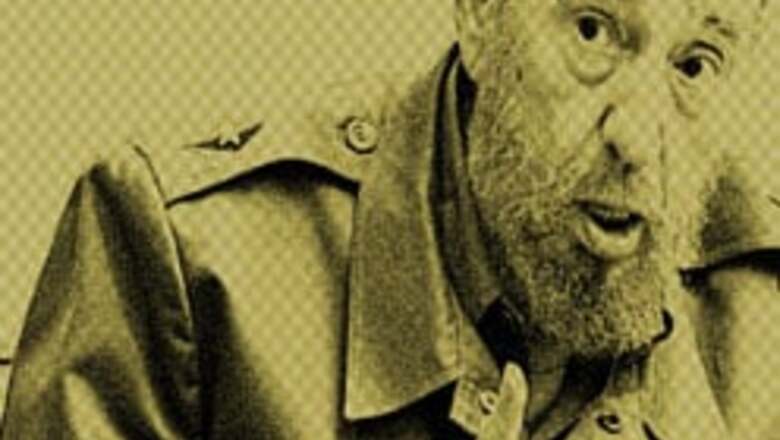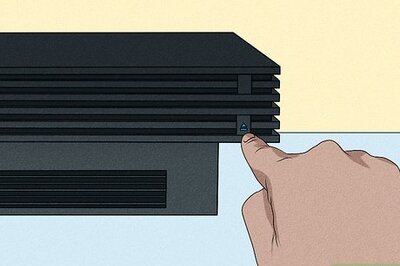
views
"Although we have been dogmatic, we have never preached cult of personality. You will not see a statue of me anywhere, nor a school with my name, nor a street, nor a little town, nor any type of personality cult because we have not taught our people to believe, but to think, to reason out,” said revolutionary and Cuban President Fidel Castro in 1985.
In his military-style uniform, long speeches and mass demonstrations, Castro always projected an image of a perpetual revolutionary though he insisted that he never wanted to promote a cult of personality.
Fidel Alejandro Castro Ruz was born on August 13, 1926 in Mayari, Oriente Province, Cuba, to Angel Castro and Lina Ruz.

Castro with his brother Raul
While Castro’s father was a wealthy landowner and sugar cane grower from Spain, his mother was a household servant.
Most sources have concluded that Castro was an intellectually gifted student though he showed more of an inclination for sports than academics.
When Castro joined the University of Havana in 1945 to study law, he became immediately fascinated by the politics on campus. The campus atmosphere during that volatile period in Cuba's history was so aggressive that organized political gangs condoning violence had become an important tool for those students aspiring to be successful leaders.
PAGE_BREAK
In 1947, growing increasingly passionate about social justice lacking under Cuba's current system, Castro joined the Partido Ortodoxos which had been newly formed by Eduardo Chibas. The same year, Castro participated in an unsuccessful rebellion in the Dominican Republic against Generalissimo Rafael Trujillo.
Castro married Mirta Diaz-Balart in 1949 and they had a son, Fidelito. They divorced in 1955. He had five other sons by his second wife, Dalia Soto del Valle – Alexis, Alexander, Alejandro, Antonio, and Angel.
He graduated from University of Havana with a doctorate in law in 1950 and established a private law practice offering free legal advice to the poor.

Castro ran for Parliament in 1952, but after General Fulgencio Batista's overthrow of the Government on March 10, Parliamentary elections were suspended.
July 26, 1953 was significant as the beginning to his revolutionary ways when he led 150 people in an attack against military barracks in Santiago with the goal of sparking an uprising against the Batista regime.
Though the attack failed, many were killed and Castro was arrested and sentenced to 15 years in prison, it shot him to fame in Cuba.
Two years later, Castro and his brother Raul were released from prison as part of an amnesty for political prisoners.
PAGE_BREAK
They went into exile and spend 1955-1956 in the US and Mexico. In Mexico, Castro met Ernesto "Che" Guevara, a theoretician of guerrilla warfare.
Guevara joined the group of rebels and became an important force in shaping Castro's evolving political beliefs. Guevara's observations of the misery of the poor in Latin America had already convinced him that the only solution lay in violent revolution.
The three organised Cuban exiles into a new guerrilla group called the 26th of July Movement, which takes its name from the failed 1953 attack.

Castro with Che Guevara
In the following years, Castro’s July 26 Movement gained popular support in the cities and countryside, and grew to over eight hundred men.
In May of 1958, Batista launched Operation Verano aiming to crush Castro and other anti-government groups.
Although on paper heavily outnumbered, Castro's guerrilla forces scored a series of victories, largely aided by mass desertions from Batista's army of poorly trained and uncommitted young conscripts. During the Battle of La Plata, Castro's forces defeated an entire battalion.
PAGE_BREAK
On January 1, 1959, Castro's army, having defeated the American-backed Batista government, rolled victoriously into Havana. As news of fall of the government spread through Havana.
Meanwhile, Cuba and the Soviet Union established diplomatic relations on in the May of 1960. Over the years, Cuba received support from the Soviet Union in the form of large subsidies.
On the other hand, relations with the US began to deteriorate and a trade embargo was imposed on Cuba in October, an embargo that remains in effect till date.

Soon, in 1961, the US broke off diplomatic relations with Cuba. The situation reached a crisis with the CIA-sponsored Bay of Pigs invasion, approved by new US President John Kennedy but planned during the previous Eisenhower administration.
A couple of months after, approximately 1,300 Cuban exiles armed with US weapons landed at the Bahia de Cochinos (Bay of Pigs) in an attempt to overthrow Castro.
PAGE_BREAK
Most were killed or captured after Kennedy cancelled air support in the face of International condemnation. On May 1, 1961, Cuba was declared a socialist state and Castro become the first and only ruler in the Western Hemisphere.
The Bay of Pigs fiasco contributed heavily to the Soviet decision to station nuclear-armed missiles in Cuba, leading to the Cuban Missile Crisis. The US declared that it would mount a strategic blockade of Cuba until the weapons are removed.

Castro with Putin in 2000
The two superpowers teetered on the brink of a nuclear war until Soviet leader Nikita Khrushchev agrees to withdraw the missiles in return for the unpublicized removal of US missiles from Turkey.
Cuba’s situation with the US remained sore and talks to normalise relations were suspended after Cuba intervened in the Angolan civil war.
In December 2000, Russian President Vladimir Putin met with Castro in Cuba. They discussed trade issues and $20 million in debt that Cuba incurred during the Soviet years.

Castro’s heath came under suspicion when after delivering a speech on October 20, 2004 he fell while leaving the podium. But after a few minutes, he addressed the crowd saying, "Just so that there won't be any speculation, it seems that I broke my knee."
This year Castro provisionally hands over power to his younger brother, Raul, while he undergoes intestinal surgery, according to a statement read on July 31 on Cuban television. The transfer of power is the first in 47 years.
PAGE_BREAK
Raul Castro is the first vice president of Cuba, and as such, the designated successor to his brother.

Cuban workers in support of Castro in Havana
Castro’s temporary handing over of power has invited extreme reactions from Cubans in Cuba and those living in exile in Little Havana in Miami.
While in Cuba people held a rally in support of Castro in Havana, holding up banners such as "Long Live Fidel, 80 more", Cuban exiles in Little Havana in Miami flooded the streets in exhilaration over the fact that power was not in Castro’s hands for a while.

Cubans in Little Havana celebrate Castro temporarily handing over power to his brother
An estimated 650,000 people of Cuban descent live in Miami, which has been remade by Cubans who left their home after Castro came to power in 1959. Many exiles view the Cuban president as a brutal dictator.
(With inputs from cnn.com)


















Comments
0 comment